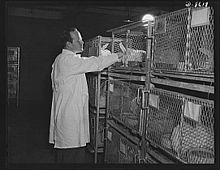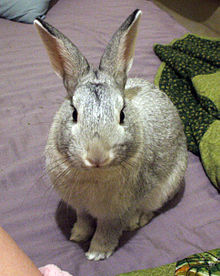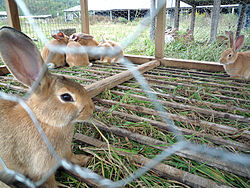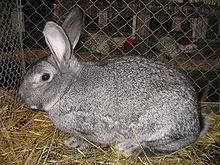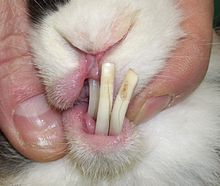- Domestic rabbit
-
This article is about domesticated European rabbits. For information on the wild variety, see European Rabbit. For general information on all rabbit species, see Rabbit.
Domestic Rabbit 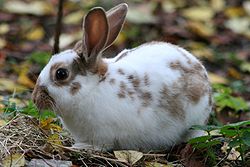
Conservation status DomesticatedScientific classification Kingdom: Animalia Phylum: Chordata Class: Mammalia Order: Lagomorpha Family: Leporidae Genus: Oryctolagus
Lilljeborg, 1873Species: O. cuniculus Binomial name Oryctolagus cuniculus
(Linnaeus, 1758)A domestic rabbit, or more commonly known as simply the rabbit, is any of the several varieties of European rabbit that have been domesticated. Male rabbits are called bucks; females are called does. An older term for an adult rabbit is coney, while rabbit referred only to the young animals.[1] More recently, the term kit or kitten has been used to refer to a young rabbit. A young hare is called a leveret; this term is sometimes informally applied to a young rabbit as well.
Contents
History
Phoenician sailors visiting the coast of Spain circa 1100s BC, mistaking the European rabbit for a species from their homeland (the rock hyrax Procavia capensis Hebrew: שפן סלע shafan sela), gave it the name i-shepan-ham. A theory exists that a corruption of this name, used by the Romans, became the Latin name for Spain, Hispania – although this theory is somewhat controversial.[2] In Rome rabbits were raised in large walled colonies.
Selective breeding of rabbits began in the Middle Ages, when they were first treated as domesticated farm animals. By the 16th century, several new breeds of different colors and sizes were being recorded.
In the 19th century, as animal fancy in general began to emerge, rabbit fanciers began to sponsor rabbit exhibitions and fairs in Western Europe and the United States. Breeds were created and modified for the added purpose of exhibition, a departure from the breeds that had been created solely for food, fur, or wool. The rabbit's emergence as a household pet began during the Victorian era.
Domestic Rabbits have been popular in the United States since the late 1800s. What became known as the "Belgian Hare Boom", began with the importation of the first Belgian Hares from England in 1888 and soon after the founding of the first rabbit club in America, the American Belgian Hare Association. From 1898 to 1901 many thousands of Belgian Hares were imported to America.[3]Today the Belgian Hare is considered one of the rarest breeds with less than 200 in the United States as reported in a recent survey.[4]
The American Rabbit Breeders Association (ARBA) was founded in 1910 and is the national authority on rabbit raising and rabbit breeds having a uniform Standard of Perfection, registration and judging system. The domestic rabbit continues to be popular as a show animal and pet. Many thousand rabbit shows occur each year and are sanctioned in Canada and the United States by the ARBA. Today the domesticated rabbit is the third most popular mammalian pet in Britain after dogs and cats.
Rabbits have and continue to be used in laboratory work such as production of antibodies for vaccines and research of human male reproductive system toxicology. The Environmental Health Perspective, published by the National Institute of Health, states, "The rabbit [is] an extremely valuable model for studying the effects of chemicals or other stimuli on the male reproductive system." According to the Humane Society of the United States, rabbits are also used extensively in the study of bronchial asthma, stroke prevention treatments, cystic fibrosis, diabetes, and cancer. Animal rights activists have opposed animal experimentation for non-medical purposes, such as the testing of cosmetic and cleaning products, which has resulted in decreased the use of rabbits in these areas.[citation needed]
Breeds
There are many different breeds of domestic rabbit, with various sizes, temperaments, and care requirements. As with breeds of dogs, rabbit breeds were selectively bred by humans at different times to achieve certain desired characteristics (including coat color and texture, size, and body shape). Care requirements have been greatly altered; for example, some new breeds need grooming a few times a day without fail, whereas others, such as the Holland lop, have a tendency to develop dental problems. Temperaments can vary slightly with breed and gender, as with any animal. There are over 50 rabbit breeds recognized by the American Rabbit Breeders Association in the United States. There are many more breeds of rabbits worldwide.
Most genetic defects in the domestic rabbit are due to recessive genes. These genes are carefully tracked by fanciers of the breeds who show them; just as dog fanciers carefully check for hip/eye and heart problems, rabbit fanciers extensively follow their own lines to remove unwanted defects. However, unpure dwarf-size breeds, which are bred for pets by non-fancier breeders, are not carefully screened for health problems, and may still develop these defects.[citation needed]
Diet
Domestic rabbits' diets consist mostly of hay, preferably as commercially made rabbit pellets or occasionally fed as loose hay. Suitable feed pellets consists of a wide variety of grasses and herbs. In contrast, lawn cutting is a poor choice for feeding as it contains very few species of grasses and no herbs, and rabbits are very susceptible to rapid changes in diet and do not react well to sudden introduction of new feeds or vegetables. Rabbit raisers provide various varieties of hay including timothy-grass, orchard grass, oat hay and alfalfa, to supplement the rabbit's normal diet of pellets and replicate their natural diet as a foraging animal. Studies have shown that although a short changeover period is needed, domestic rabbits are highly adaptable to diets produced from locally available forage products in developing countries.[5] Overfeeding of leafy green vegetables often leads to diarrhea, and too many pellets or sugary fruits can lead to other health problems.
Coprophagy and rabbits
Rabbits are hindgut fermenters and therefore have an enlarged cecum. The cecum allows rabbits to digest, via fermentation (biochemistry) what they otherwise would not be able to metabolically process. Because a rabbit has a sensitive and rather substantial gastrointestinal tract, a rabbit’s diet should consist of some amount of fiber. Without a proper diet, gastrointestinal stasis can occur and have detrimental effects on the animal itself.[6] It is in the cecum that this fiber is digested.
After a rabbit ingests food, the food travels down the esophagus and through a small valve called the cardia. In rabbits, this valve is very well pronounced and makes the rabbit incapable of vomiting. The food enters the stomach after passing through the cardia. Food then moves to the stomach and small intestine where a majority of nutrient extraction and absorption takes place. Food then passes into the colon and eventually into the cecum. Peristaltic muscle contractions (waves of motion) help to separate fibrous and non-fibrous particles. The non-fibrous particles are then moved backwards up the colon, through the illeo-cecal valve, and into the cecum. Symbiotic bacteria in the cecum help to further digest the non-fibrous particles into a more metabolically manageable substance. After as little as three hours, a soft, fecal pellet, called a cecotrope, is expelled from the rabbit’s anus. The rabbit instinctively eats these grape-like pellets, without chewing, in exchange keeping the mucous coating intact. This coating protects the vitamin- and nutrient-rich bacteria from stomach acid, until it reaches the small intestine, where the nutrients from the cecotrope can be absorbed.[7]
The soft pellets contain a sufficiently large portion of nutrients that are critical to the rabbit’s health. This soft fecal matter is rich in vitamin B and other nutrients. The process of coprophagy is important to the stability of a rabbit’s digestive health because it is the only way in which a rabbit receives vitamin B in a form that is useful to its digestive wellness.[8] Occasionally, the rabbit may leave these pellets lying about its cage; this behavior is harmless and usually related to an ample food supply. If their caecal pellets are consistently wet and runny, this can indicate either too little fiber or too many starches in the diet. This probably means that they need to be fed additional hay.
Rabbits as pets
Rabbits have been kept as pets in Western nations since the 19th century. Rabbits kept indoors with proper care have a lifespan between 8 to 12 years.[9] Rabbits are especially popular as pets in the US during the Easter season, due to their association with the holiday. However, animal shelters that accept rabbits often complain that during the weeks and months following Easter, there is a rise of unwanted and neglected rabbits that were bought as Easter "gifts", especially for children.[10]
Pet rabbits can be kept outdoors or indoors. Accommodations can range from an outdoor hutch to an indoor cage or pen to the free run of the home.
Care
Rabbits are relatively inexpensive to keep when compared to larger animals such as dogs or horses, although their care can still be moderately costly.[11] Rabbits raised in the United States do not require any vaccinations. Rabbits in the United Kingdom require viral haemorrhagic disease and Myxomatosis vaccinations. Veterinary care is fairly limited and disease is rare when rabbits are raised in sanitary conditions and cared for adequately. Regular brushing of the coat helps to decrease chances of fur ingestion which can lead to fur ball impaction of the stomach. Regular trimming of the nails is required if pet rabbits live indoors where they can not dig.
Improper holding or handling of pet rabbits can lead to strong kicks by the frightened rabbit which can injure both the animal and the handler.[12]
Rabbits will gnaw on anything that is available to them, including electrical cords, cables, and paper products. Electrical components, when chewed by pet rabbits, can cause electrocution and burns.[13]
Commercial rabbits
Meat rabbits
Breeds such as the New Zealand and Californian are frequently utilized for meat in commercial rabbitries. These breeds have efficient metabolisms and grow quickly; they are ready for slaughter by approximately 14 to 16 weeks of age.
Rabbit fryers are rabbits that are between 70 to 90 days of age, and weighing between 3 to 5 lb (1 to 2 kg) live weight. Rabbit roasters are rabbits from 90 days to 6 months of age weighing between 5 to 8 lb (2 to 3.5 kg) live weight. Rabbit stewers are rabbits from 6 months on weighing over 8 lb.
Any type of rabbit can be slaughtered for meat, but those exhibiting the "commercial" body type are most commonly raised for meat purposes. Dark fryers (any other color but albino whites) are sometimes lower in price than albino fryers because of the slightly darker tinge of the fryer (purely pink carcasses are preferred by consumers) and because the hide is harder to remove manually than the white albino fryers.
Well-known chef Mark Bittman says that domesticated rabbit tastes like chicken because both are blank palettes upon which any desired flavors can be layered.[14]
Wool rabbits
Rabbits such as the Angora, American Fuzzy Lop, and Jersey Wooly produce wool. However, since the American Fuzzy Lop and Jersey Wooly are both dwarf breeds, only the much larger Angora breeds such as the English Angora, Satin Angora, Giant Angora, and French Angoras are used for commercial wool production. Their long fur is sheared, combed, or plucked (gently pulling loose hairs from the body during molting) and then spun into yarn used to make a variety of products. Angora sweaters can be purchased in many clothing stores and is generally mixed with other types of wool. Rabbit wool, called Angora, is 5 times warmer than sheep's wool.[citation needed]
Fur rabbits
All rabbits produce fur. Rabbits such as the Palomino, Satin, Chinchilla rabbit and Rex rabbit are commonly raised for fur. Each breed has unique coloring and fur characteristics. The rabbit is fed a diet especially balanced for fur production and the pelts are harvested when they have reached prime condition. Rabbit fur is widely used throughout the world. China imports much of its fur from Scandinavia (80%) and North America (5%) according to the USDA Foreign Agricultural Service GAIN Report CH7607.
Laboratory rabbits
Rabbits have been and continue to be used in laboratory work such as production of antibodies for vaccines and research of human male reproductive system toxicology. In 1972, around 450 000 rabbits were used for experiments in the United States, decreasing to around 240 000 in 2006.[15] The Environmental Health Perspective, published by the National Institute of Health, states, "The rabbit [is] an extremely valuable model for studying the effects of chemicals or other stimuli on the male reproductive system."[16] According to the Humane Society of the United States, rabbits are also used extensively in the study of bronchial asthma, stroke prevention treatments, cystic fibrosis, diabetes, and cancer.
Animal rights activists generally oppose animal experimentation for all purposes, and rabbits are no exception.[improper synthesis?] The use of rabbits for the Draize test,[17] which is used for, amongst other things, testing cosmetics on animals, has been cited as an example of cruelty in animal research. Albino rabbits are typically used in the Draize tests because they have less tear flow than other animals and the lack of eye pigment make the effects easier to visualize.[citation needed]
Outdoor housing
Rabbits can live outside in properly constructed housing or hutches. Hutches provide protection from the elements in winter and keep rabbits cool in summer heat. To protect from predators rabbit hutches are usually situated in a fenced yard, shed, barn, or other enclosed structure. Whether housed indoors or out, all rabbits can be provided shelves, ramps or tunnels, toys or other enrichment items. Rabbit waste can be measured in cubic yards per year. This waste is excellent for gardening and composting, and can be collected for these uses whether the rabbit is housed indoors or outdoors. An outdoor cage should be as large as possible, at least high enough for the rabbit to stand on its back legs without its head touching the ceiling. It should be large enough to enable the rabbit to take 4 or 5 hops along its length and width. The shelter may be heated in winter (although most rabbits can be kept outside with extra bedding even into temperatures well below freezing) and should be shaded or otherwise appropriately cooled in summer. Clean water must be available at all times, especially in hot weather to keep temperatures below 85 degrees. Large rabbits (such as the New Zealand breed) do fine in temperatures as low as -10 degrees Celsius/15 degrees Fahrenheit in a hutch with plenty of straw, if their needs for food and water are well met. Water cups or bottles that become frozen in cold weather must be changed two or three times daily. Below -10 degrees Celsius/15 degrees Fahrenheit it is necessary to shelter all animals in a barn or basement or garage. Covering cages three quarters of the way with a blanket, several cages grouped together, can generate a great deal of heat. One rule of thumb is at least eight pounds of animal per cage. Even newborn rabbits do well in cold if they have sufficient nest and many siblings to snuggle with. They should stay with the mother for longer periods of time in the winter for warmth. Domesticated rabbits are most comfortable in temperatures between 10 to 21 degrees C (50 to 70 degrees F), and cannot endure temperatures above 32 degrees C (90 degrees F) well without assistance such as deep shade, cold stones, frozen water bottles or fans.
Rabbits require clean environments and all housing should be cleaned regularly to ensure that no build-up of feces or urine occurs. Rabbit droppings are often left in beds with red worms to create compost, added to compost bins for enrichment of the compost, or applied directly to a garden as a "cool" fertilizer that will not burn plants.
Rabbits can be litter trained, which makes it much easier to clean up after them. Dust free litter that will not cause health problems if ingested is used for rabbits.
Exhibition
Conformation shows
Show rabbits are an increasingly popular wholesome activity for individuals and families. Showing rabbits helps to improve the vigor and physical behavior of each breed through competitive selection. County fairs are common venues through which rabbits are shown in the United States. Rabbit clubs at local state and national levels hold many shows each year. On any given weekend one may be able to find a show in most regions of the United States and the United Kingdom. Although only purebred animals are shown, a pedigree is not required to enter a rabbit in an ARBA-sanctioned show but is required to register your rabbit with the American Rabbit Breeders Association (ARBA). A rabbit must be registered in order to receive a Grand Champion certificate.[18] Children's clubs such as 4-H also include rabbit shows, usually in conjunction with county fairs. The ARBA holds an annual national convention which has as many as 25,000 animals competing form all over the world. The mega show moves to a different city each year. The ARBA also sponsors youth programs for families as well as underprivileged rural and inner city children to learn responsible care and breeding of domestic rabbits.
Show jumping
Rabbit show jumping, a form of athletic competition between rabbits, began in the 1970s and has since become popular in Europe, particularly Sweden and the United Kingdom. Any rabbit regardless of breed may participate in this kind of competition, as it is based on athletic skill.
Genetics
Reference: Rabbit Coat Color Genetics: Gene List
There are 10 color gene groups (or loci) in rabbits. They are A, B, C, D, E, En, Du, Si, V, and W. Each locus has dominant and recessive genes. In addition to the loci there are also modifiers, which modify a certain gene. These include the rufus modifiers, color intensifiers, and plus/minus (blanket/spot) modifiers. A rabbit's coat only has two pigments, pheomelanin (yellow) and eumelanin (dark brown). There can also be no pigment, causing an albino or white rabbit.
Color Genes
Within each group, the genes are listed in order of dominance, with the most dominant gene first. In parenthesis after the description is at least one example of a color that displays this gene.
- Note: lower case are recessive and capital letters are dominant
- "A" represents the agouti locus (multiple bands of color on the hair shaft). The genes are:
- A= agouti ("wild color" or chestnut agouti, opal, chinchilla, etc.)
- a(t)= tan pattern (otter, tan, silver marten)
- a= self or non-agouti (black, chocolate)
- "B" represents the brown locus. The genes are:
- B= black (chestnut agouti, black otter, black)
- b= brown (chocolate agouti, chocolate otter, chocolate)
- "C" represents the color locus. The genes are:
- C= full color (black)
- c(ch3)= dark chinchilla, removes yellow pigmentation (chinchilla, silver marten)
- c(ch2)= medium (light) chinchilla, Slight reduction in eumelanin creating a more sepia tone in the fur rather than black.
- c(ch1)= light (pale) chinchilla (sable, sable point, smoke pearl, seal)
- c(h)= Himalayan, body white with extremities ("points") colored in black, blue, chocolate or lilac, pink eyes
- c= albino (ruby-eyed white or REW)
- "D" represents the dilution locus. This gene dilutes black to blue and chocolate to lilac.
- D= dense color (chestnut agouti, black, chocolate)
- d= diluted color (opal, blue or lilac)
- "E" represents the extension locus. It works with the 'A' and 'C' loci, and rufus modifiers. When it is recessive, it removes most black pigment. The genes are:
- E(d)= dominant black
- E(s)= steel (black removed from tips of fur, which then appear golden or silver)
- E= normal
- e(j)= Japanese brindling (harlequin), black and yellow pigment broken into patches over the body. In a broken color pattern this results in Tricolor.
- e= most black pigment removed (agouti becomes red or orange, self becomes tortoise)
- "En" represents the plus/minus (blanket/spot) color locus. It is incompletely dominant and results in three possible color patterns:
- EnEn= "Charlie" or a lightly marked broken with color on ears, on nose and sparsely on body
- Enen= Broken rabbit with roughly even distribution of color and white
- enen= Solid color with no white areas
- "Du" represents the Dutch color pattern, (the front of the face, front part of the body, and rear paws are white, the rest of the rabbit has colored fur). The genes are:
- Du= absence of Dutch pattern
- du(d)= Dutch (dark)
- du(w)= Dutch (white)
- "V" represents the vienna white locus. The genes are:
- V= normal color
- Vv= Vienna carrier, carries blue-eyed white gene. May appear as a solid color, with snips of white on nose and/or front paws, or Dutch marked.
- v= vienna white (blue-eyed white or BEW)
- "Si" represents the silver locus. The genes are:
- Si= normal color
- si= silver color (silver, silver fox)
- "W" represents the middle yellow-white band locus and works with the agouti gene. The genes are:
- W= normal width of yellow band
- w= doubles yellow band width (Otter becomes Tan, intensified red factors in Thrianta and Belgian Hare)
- "P" represents the OCA type II form of albinism, P is because it is an integral P protein mutation. The genes are:
- P= normal color
- p= albinism mutation, removes eumelanin and causes pink eyes. (Will change, for example, a Chestnut Agouti into a Shadow)
Health problems
Fly strike
Fly strike is a rare condition which mostly affects rabbits kept in extremely unsanitary conditions and is more likely to occur during summer months. Fly strike happens when flies (particularly the Botfly) lay their eggs in the damp or soiled fur or in an open wound of a rabbit. Within 12 hours, the eggs hatch into the larvae stage of the fly, known as maggots. The maggots, initially small and almost invisible to the naked eye, can burrow into the skin of the rabbit and feed on the animal's tissue. Within 3–4 days, the larvae can be large as 15 mm long. In rare cases, if not treated, the rabbit can pass into shock and die. The most susceptible animals are those living in unsanitary housing, older rabbits who do not move much, and those who are unable to clean their bottom areas carefully. Rabbits raised on solid floors are more susceptible than rabbits raised on wire floors. Rabbits exhibiting one or more episodes of diarrhea are often inspected, especially during the summer months.[19] In 2002, the medicine Rearguard was approved in the United Kingdom for a 10-week per-application prevention of Fly strike.
Myxomatosis and West Nile Virus
Myxomatosis is a threat to the health of pet rabbits. Rabbits caged outdoors in Australia are vulnerable in areas with high numbers of mosquitoes. In Europe, fleas are the carriers of myxomatosis. In some countries, annual vaccinations against myxomatosis are available. In Australia pet rabbits cannot be vaccinated against myxomatosis which was introduced to the wild rabbit population as a means of population control. The Australian Government will not allow veterinarians to purchase and use the vaccine that would protect pet rabbits.[citation needed]
West Nile Virus is another threat to rabbits.[20] This is a fatal disease, and while there are vaccines available, they are not specifically indicated for rabbits. Recourse against the disease includes limiting the number of mosquitoes that are around pet rabbits.
Sore hocks
The formation of open sores on the rabbit's hocks, commonly called "sore hocks," is a problem that commonly afflicts mostly heavy-weight rabbits kept in cages with wire flooring or soiled solid flooring. The problem is most prevalent in rex-furred rabbits and heavy-weight rabbits (9+ pounds in weight). The condition results when, over the course of time, the protective bristle-like fur on the rabbit's hocks thins down. Standing urine or other unsanitary cage conditions can exacerbate the problem by irritating the sensitive skin. The exposed skin can result in tender areas or, in severe cases, open sores. The sores can become infected and abscessed if not properly cared for. The problem has a genetic component and animals exhibiting thin foot bristles should not be saved for breeding. Most rabbits can live safely on wire floors with the provision of a resting board or mat. Ultra heavy-weight breeds such as Flemish Giants or Checkered Giants are best raised on solid or partially solid flooring.
Respiratory infections
An over-diagnosed ailment amongst rabbits is respiratory infection. Pasteurella bacteria, known colloquially as "snuffles," is usually misdiagnosed and has been known to be a factor in the overuse of antibiotics among rabbits.[21]
A runny nose, for instance, can have several causes, among those being high temperature or humidity, extreme stress, environmental pollution (like perfume or incense), or a sinus infection. Options for treating this is removing the pollutant, lowering or raising the temperature accordingly, and medical treatment for sinus infections.[21]
"Runny eyes" can be caused by dental disease or a blockage of the tear duct. Environmental pollution, corneal disease, entropion, distichiasis, or inflammation of the eyes are also causes. This is easy to diagnose as well as treat.[21]
Sneezing can be a sign of environmental pollution (such as too much dust) or food allergy.
While Pasteurella is a bacterium that lives in a rabbit's respiratory tract, it can flourish out of control in some cases. In the rare event that happens, antibiotic treatment is necessary.
Head tilt/wry neck/Encephalitozoon cuniculi (E. cuniculi)
Inner ear infections, certain protozoans, strokes, or other diseases or injuries affecting the brain or inner ear can lead to a condition known as wry neck or "head tilt." Although a heavy infestation of ear mites, an ear infection or injury can result in these symptoms, the most common cause of these symptoms is the protozoan parasite E. cuniculi. This condition can be fatal, due to a disorientation that causes the animal to stop eating and drinking. The drugs of choice for treatment and prevention of E. cuniculi infections are the benzimidazole anthelmintics, particularly fenbendazole. In the UK, Panacur Rabbit (containing fenbendazole) is marketed and recommended as a nine day course to help contain this condition and is a simple oral paste to medicate at home. It is sold over the counter. Users in the US or other countries will need to consult with their veterinarians about use and dosage of fenbendazole.
Teeth problems
Dental disease has several causes, namely genetics, inappropriate diet, injury to the jaw, infection, or cancer.
- Malocclusion: Rabbit teeth are open-rooted and continue to grow throughout their lives. In some rabbits, the teeth are not properly aligned, a condition called malocclusion. Because of the misaligned nature of the rabbit's teeth, there is no normal wear to control the length to which the teeth grow. There are three main causes of malocclusion, most commonly genetic predisposition, injury, or bacterial infection. In the case of congenital malocclusion, treatment usually involves veterinary visits in which the teeth are treated with a dental burr (a procedure called crown reduction or, more commonly, teeth clipping) or, in some cases, permanently removed. In cases of simple malocclusion, a block of wood for the rabbit to chew on can rectify this problem[citation needed].
- Molar spurs: These are spurs that can dig into the rabbit's tongue and/or cheek causing pain. These can be filed down by an experienced veterinarian with a dental burr.
Signs of dental difficulty include difficulty eating, weight loss and small stools, anorexia, and visibly overgrown teeth. However, there are many other causes of ptyalism, including pain due to other causes.[22] A visit to an experienced rabbit veterinarian is strongly recommended in the case of a wet chin, or excessive grooming of the mouth area.
Gastrointestinal stasis
Gastrointestinal stasis is a serious and potentially fatal condition that occurs in some rabbits in which gut motility is severely reduced and possibly completely stopped. When untreated or improperly treated, GI stasis can be fatal in as little as 24 hours.
GI stasis is the condition of food not moving through the gut as quickly as normal. The gut contents may dehydrate and compact into a hard, immobile mass (impacted gut), blocking the digestive tract of the rabbit. Food in an immobile gut may also ferment, causing significant gas buildup and resultant gas pain for the rabbit.
The first noticeable symptom of GI stasis may be that the rabbit suddenly stops eating. Treatment frequently includes subcutaneous fluid therapy (rehydration through injection of saline solution under the skin), drugs for treatment of the buildup of gas in the digestive tract, massage to promote gas expulsion and comfort, possible drugs to promote gut motility, and careful monitoring of all inputs and outputs. The rabbit's diet may also be changed as part of treatment.
Some rabbits are more prone to GI stasis than others. The causes of GI stasis are not completely understood, but common contributing factors are thought to include:
- a lack of fiber in the diet. Many pet rabbits do not get sufficient hay, but are instead mistakenly fed only commercial alfalfa pellets originally developed for rapidly increasing mass in rabbits bred for meat.
- insufficient moisture in the diet. Fresh, leafy greens are a critical part of a rabbit's diet in part because of their moisture content, which helps prevent the gut contents from becoming impacted.
- lack of exercise. Rabbits confined to a cage frequently do not get the opportunity (or motivation) to run, jump, and play, which is critical in maintaining gut motility.
In addition, GI stasis can be caused by the rabbit not eating for other reasons, such as stress, dental problems, or other unrelated health problems.
GI stasis is sometimes misdiagnosed as cat-like "hair balls" by veterinarians not familiar with rabbit physiology.[23][24] However, unlike cats, rabbits do not have the ability to vomit.
Veterinary care
Rabbits visit the vet for routine check ups, vaccination and when ill or injured. Some veterinary surgeons have a special interest in rabbits and some have extra qualifications. In the UK the following post graduate qualifications demonstrate specialist training in rabbits: Certificate in Zoological Medicine, Diploma in Zoological Medicine and Recognised specialist in Rabbit Medicine and Surgery.[25]
Routine checkups
Routine check ups usually involve assessment of weight, skin, health and teeth by the owner or a veterinarian. This is essential because a rabbit's health and welfare can be compromised by being overweight or underweight or by having dental problems. Checking the teeth is particularly important part of the examination as back teeth can only be seen with a otoscope. Veterinarians can also give personalised advice on diet and exercise.
Vaccinations
Rabbits should be vaccinated against Myxomatosis and Viral Haemorrhagic Disease in the UK.[26] These vaccinations are usually given annually, two weeks apart. If there is an outbreak of Myxomatosis locally this vaccine can be administered every six months for extra protection.[27] However, Myxomatosis immunisations are not available in all countries, including Australia, because of the risk that immunity will pass onto wild rabbits, which is what the disease was created for (the extermination of wild rabbits).
Worming
Some vets now recommend worming all rabbits against the parasite Encephalitozoon cuniculi. Some studies have indicated that in the UK over 50% of rabbits may be infected with this parasite. Fenbendazole is used as a deworming agent in other species of animal and has shown to be effective in treating rabbits. In the UK it is now sold in paste form as a treatment for rabbits under the brand name Panacur. It is particularly recommended for rabbits kept in colonies and before mixing new rabbits with each other.[28]
Ill or Injured
Some of the conditions that can occur in domestic rabbits include the following: dramatic or sudden loss of appetite, severe depression,[29] breathing problems,[30] sudden onset of head tilt, signs of maggot infestation,[31] not passing stools. Rabbits can also be exposed to poisons, involved in an accident, fall from a height or be exposed to smoke. Other rabbits conditions which indicate a need for medical treatment are drooling, unexplained weight loss, diarrhoea or fur loss. There are many other symptoms for which a rabbit requires medical aid or veterinary attention.
See also
References
- ^ Online Etymology Dictionary
- ^ Anthon, Charles. A System of Ancient and Mediæval Geography for the Use of Schools and Colleges pg.14
- ^ http://www.albc-usa.org/cpl/belgianhare.html
- ^ Hare Surveyhttp://www.belgianhareclub.com/hare_survey.html
- ^ J.A. Lowe (2006). "Pet Rabbit Feeding and Nutrtion". The Nutrition of the Rabbit: 309–323.
- ^ Krempels, Ph.D., Dana M. "GastroIntestinal Stasis: The Silent Killer." University of Miami Department of Biology. Web. 19 Apr. 2011. <http://www.bio.miami.edu/hare/ileus.html>.
- ^ The American Rabbit Breeders Ass'n., Inc. Official Guidebook: to Raising Better Rabbits and Cavies. Bloomington, IL: American Rabbit Breeders Association, 1991. Print.
- ^ "Purina Mills Rabbit - NUTRITION & MANAGEMENT." Purina Mills Rabbit - Home. Web. 19 Apr. 2011. <http://www.rabbitchow.com/NUTRITIONMANAGEMENT/default.aspx>.
- ^ "What's the lifespan of a rabbit?". House Rabbit Society. http://www.rabbit.org/fun/life-span.html. Retrieved 2007-10-11.
- ^ ABC7 Chicago (TV station) article "Easter Rabbits"
- ^ "Choosing a Rabbit as a Pet". Peteducation.com. http://www.peteducation.com/article.cfm?c=18+1803&aid=2511. Retrieved 2010-12-11.
- ^ "Children and Rabbits". The House Rabbit Society. http://www.rabbit.org/faq/sections/children.html. Retrieved 2010-12-11.
- ^ "Dealing with Medical Emergencies". The House Rabbit Society. http://www.rabbit.org/journal/2-4/emergency-preparedness.html. Retrieved 2010-12-11.
- ^ "How to Cook Everything :: Braised Rabbit with Olives". 2008. Archived from the original on 2008-05-17. http://web.archive.org/web/20080517134208/http://www.howtocookeverything.tv/htce/TakeOnTheRecipes/detail/recipeId-24.html. Retrieved 2008-07-17.
- ^ Kulpa-Eddy. "A review of trends in animal use in the United States (1972–2006)". AATEX (Proc. 6th World Congress on Alternatives & Animal Use in the Life Sciences) (14, Special Issue): 163–165. http://www.soc.nii.ac.jp/jsaae/zasshi/WC6_PC/paper163.pdf.
- ^ Morton, Daniel (April 1988). "The use of rabbits in male reproductive toxicology". Environmental Health Perspectives (National Institute of Health) 77: 5–9. doi:10.2307/3430622. JSTOR 3430622. PMC 1474531. PMID 3383822. http://www.pubmedcentral.nih.gov/articlerender.fcgi?tool=pmcentrez&artid=1474531.
- ^ M.K. Prinsen (2006). "The Draize Eye Test and in vitro alternatives; a left-handed marriage?". Toxicology in Vitro 20 (1): Pages 78–81. doi:10.1016/j.tiv.2005.06.030. PMID 16055303.
- ^ Official Show Rules. American Rabbit Breeders Association. 2009
- ^ House Rabbit Society: Fly strike
- ^ http://www.cdc.gov/ncidod/dvbid/westnile/qa/transmission.htm
- ^ a b c Respiratory Disease by Dr. Susan A. Brown DVM
- ^ MediRabbit: Differential Diagnosis for Ptyalism
- ^ House Rabbit Society: Sluggish Motility in the Gastrointestinal Tract
- ^ University of Miami Department of Biology: Gastrointestinal Stasis, The Silent Killer
- ^ The Royal College of Veterinary Surgeons http://www.rcvs.org.uk/Templates/Internal.asp?NodeID=94964
- ^ British Veterinary Association Rabbit Care Downloads http://www.link2content.co.uk/uploads/bva/rabbit.pdf
- ^ http://www.intervet.co.uk/binaries/92_114377.pdf Intervet vaccination literature.
- ^ http://www.houserabbit.co.uk/resources/content/info-sheets/ecuniculi.htm RWAF Encephalitozoon Cuniculi
- ^ Harcourt-Brown F (2002). "Anorexia in rabbits 2". In Pract 24 (8): 450–67.. doi:10.1136/inpract.24.8.450.
- ^ Paul-Murphy J (2007). "Critical care of the rabbit". Vet Clin North Am Exot Anim Pract. 10 (2): 437–61.. doi:10.1016/j.cvex.2007.03.002. PMID 17577559.
- ^ Cousquer G , 28: (2006). "Veterinary care of rabbits with myiasis". In Pract. 1028 (6): 342–349..
External links
- The American Rabbit Breeders Association, the oldest and largest rabbit specialist organization in the United States.
- American Livestock Breeds Conservancy, A registry of the most endangered or rare breeds of domestic rabbits.
- World Rabbit Science Association An international science organization dedicated to rabbit health research.
- The British Rabbit Council, recognised breeds with photographs and more.
- MediRabbit A site dedicated to spreading the knowledge of rabbit medicine and safe medication in rabbits, for the owner and the vet professional.
- Rabbitshows.com, A site with information on showing domestic rabbits.
- Illustrated Edible Guide: Safe plants, fruit, berries, branches, vegetables and herbs for rabbits to eat
- Rabbit colors database: Search for rabbits in specific colors or add your own to the database
Categories:- Domesticated animals
- Pet rabbits
- Livestock
Wikimedia Foundation. 2010.

